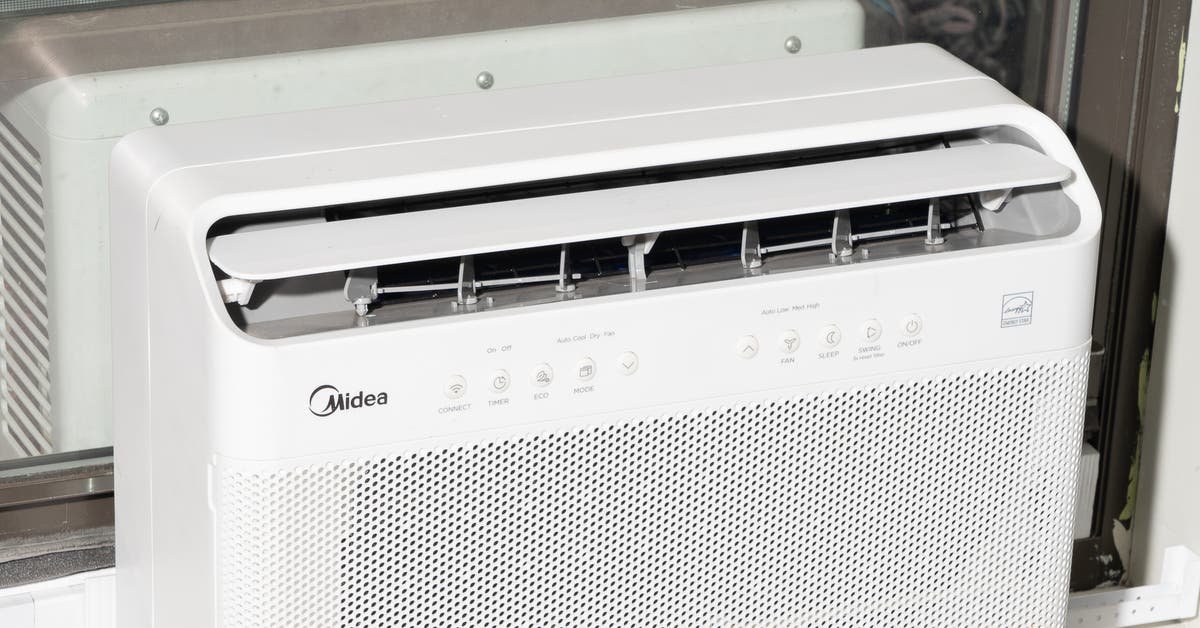
Top pick

This U-shaped Midea air conditioner is the quietest model we’ve ever tested, and it’s designed in a way that still allows you to open your window. But the installation process isn’t fun.
When the U-shaped Midea U MAW08V1QWT arrived, in spring of 2020, we initially rolled our eyes at its ambitious promise to “reinvent” the air conditioner. But after living with it for several summers, we can say with confidence that it is genuinely the best window air conditioner we’ve ever tested—with one of the worst AC installation processes we’ve ever suffered through.
The Midea U is impressively powerful, without using a lot of energy. Standard AC compressors have only two settings—on or off. But the Midea U has an inverter compressor that runs at varying speeds. This modulates electrical consumption, rarely running full throttle. So the Midea U uses only about half as much energy as an air conditioner that hits the minimum efficiency standards established by the EPA. This translates to an energy-efficiency ratio of 15, compared with an EER of 11 or 12 for a non-inverter model. In our tests, on hot days we’ve watched the Midea U fluctuate between 100 and 300 watts over the course of several hours—even though it’s rated to run at up to 710 watts. Once the room hits a target temperature, the Midea U maintains consistent conditions without using a ton of energy.
Thanks to this model’s unique design, you can continue to use your window. Most air conditioners are just one big metal box that requires you to pull the window down against the top to help keep it in place. But the Midea U boasts a curious U shape, with a “canyon” in the center that you pull the window down into, separating the fan on the inside from all the heavy hardware on the outside. It also has extendable side bars that lock it into place with the window frame—so you can open the window without worrying that the AC will fall out.
The Midea U is also one of the absolute quietest ACs we’ve ever tested. This is another perk of the U-shaped design: All of the louder hardware gets moved to the other side of the window, with the glass helping to mute the sound even more. (Though the aforementioned inverter compressor is already quieter than standard AC compressors, even without the window buffer.) In our tests, it was actually difficult to get an accurate volume reading from the Midea U—it just blended in with the empty room tone, between 35 and 40 decibels. There was a slight high-pitched boost when the compressor was running on high, but even that was barely noticeable.
The smart-home features are surprisingly robust. In addition to creating a recurring schedule, the Midea app lets you set up a Sleep Curve, which adjusts the temperature with precision over an eight-hour period (presumably when you’re sleeping and don’t want to wake up in a room as cold as the one you passed out in). It works with Amazon Alexa and Google Assistant, too, and the language is impressively natural. For example, you can say, “Turn on Midea” or “Set Midea to 62 degrees,” and it actually works (which, in our experience, is frustratingly uncommon for this product category).

The Midea U is surprisingly affordable—even before you factor in the free bracket. The average cost for an 8,000-Btu Midea U is currently around $400, which is about what you’d pay for a similarly sized AC with a standard compressor (and less than you’d pay for an inverter-style unit, even one without smart-home controls). And thanks to its unique design, the Midea U also comes with its own window bracket. This bracket is similar to our top-pick window bracket, the Top Shelf TSB-2438, which typically hovers near $100 on its own (though you can find other brackets for as low as $30).
You’ve got options on sizing. The Midea U is also available in a 10,000-Btu model, for rooms up to 450 square feet. There’s also a Costco-exclusive 12,000-Btu version, for rooms up to 550 square feet; this one comes with a built-in air ionizer. (We’re typically skeptical of the health claims surrounding this technology, but it probably doesn’t hurt, either.)

Flaws but not dealbreakers
Cleaning it can be a challenge. Some user reviews of the Midea U that note some nasty gunk building up on the fan, or in the rear basin. Grit, dust, and sometimes fungal spores can be a problem with any air conditioner, but it may be more difficult to deal with—or at least more noticeable—due to the Midea’s visible but hard-to-access front fan assembly.
It’s not an issue we’ve noticed ourselves, and we’ve been testing the same Midea U since 2020. Based on the comments we’ve seen, the problem seems particularly common with oversized units, which may extract more humidity from the air than the typical fan cycle can handle. (A standard 8,000 BTU air conditioner, for example, is designed for spaces up to 350 square feet; if you bought a 12,000 BTU unit for the same size room, that would be considered oversized.)
Adam Schultz, the Residential Air Conditioner Platform Manager at Midea, told us that the company is aware of these concerns, and is working on a new set of instructions and videos to guide people through the cleaning process. “All window air conditioners hold water in the basepan on the outdoor side, [so] it is open to the elements and other variables with any sort of microbial growth,” he said, adding that, “We think the Midea U is unique in that people are noticing this more because the outdoor side is more visible since the window is closed.” He also assured us that any gross things growing on the outside of the unit would not affect the air on the indoor side, since they’re separated from the actual air cycle.
Anecdotally, we’ve found that the Midea is less likely to run into moisture issues when it’s running regularly on the “auto” setting, which makes the fan run every ten minutes; this is true even in humid locations that also attract algae and other growths. You can also run the fan manually for a few hours after the AC has finished cooling the room to make sure that any excess moisture has evaporated. Schultz at Midea also suggested placing disinfectant tablets in the basepan, or using liquid dish soap to spray down the outdoor coil (though you should make sure the soap is all rinsed before you run the machine again).
Others have complained about the Midea smart-home app. We had no problems with the Midea Air app in our first few years of testing. In 2023, however, the company began sunsetting that app, consolidating all of its smart-home controls in the more-robust MSmartHome app. Though a representative for Midea told us that the Midea Air app would continue to be supported through the summer, we’ve heard from several readers who’ve had issues setting up their air conditioners using the older app. We think these problems should be resolved as things transition over to the MSmartHome app.
The installation process is a special kind of hell. I think we can all agree that installing any air conditioner in your window is a process that quite frankly sucks. I say this as a 6-foot-tall, 200-pound man, while recognizing that there are many people who are smaller or less able-bodied than me for whom it sucks even more. But the Midea U’s quirky design makes this AC an outlier in a field already known for its frustrations.
In fact, during our initial tests, I got so frustrated with the Midea U’s useless documentation that I gave up reading and just tried to muscle it into place—which is how I realized that if you treat this model as you would a normal AC, it’s actually pretty easy to install. (In other words, don’t overthink it.) By year three, I’d become a master of the quick installation process. There’s hope for you yet, young Padawan.
Here are a few installation tricks I’ve learned along the way:
- Every window is a little different, but the Midea U comes with enough modular hardware, padding, and other options that you should be able to make it work.
- Place the bracket on the sill so it’s stable-ish, but don’t lock the legs right away. Set the AC on top of the bracket until you feel it settle snugly into place.
- Locate the extendable metal bars at the bottom of the AC “canyon.” Slide them into the window tracks. Use that as your anchor.
- Slide the window down to make sure it fits into the canyon.
- Lift the window back up, and then lock everything else into place.
- Using the included hardware, secure everything as necessary for your specific window. Then while you’re at it, slap some insulation padding everywhere you can.
Other than that, YouTube is always your friend.





